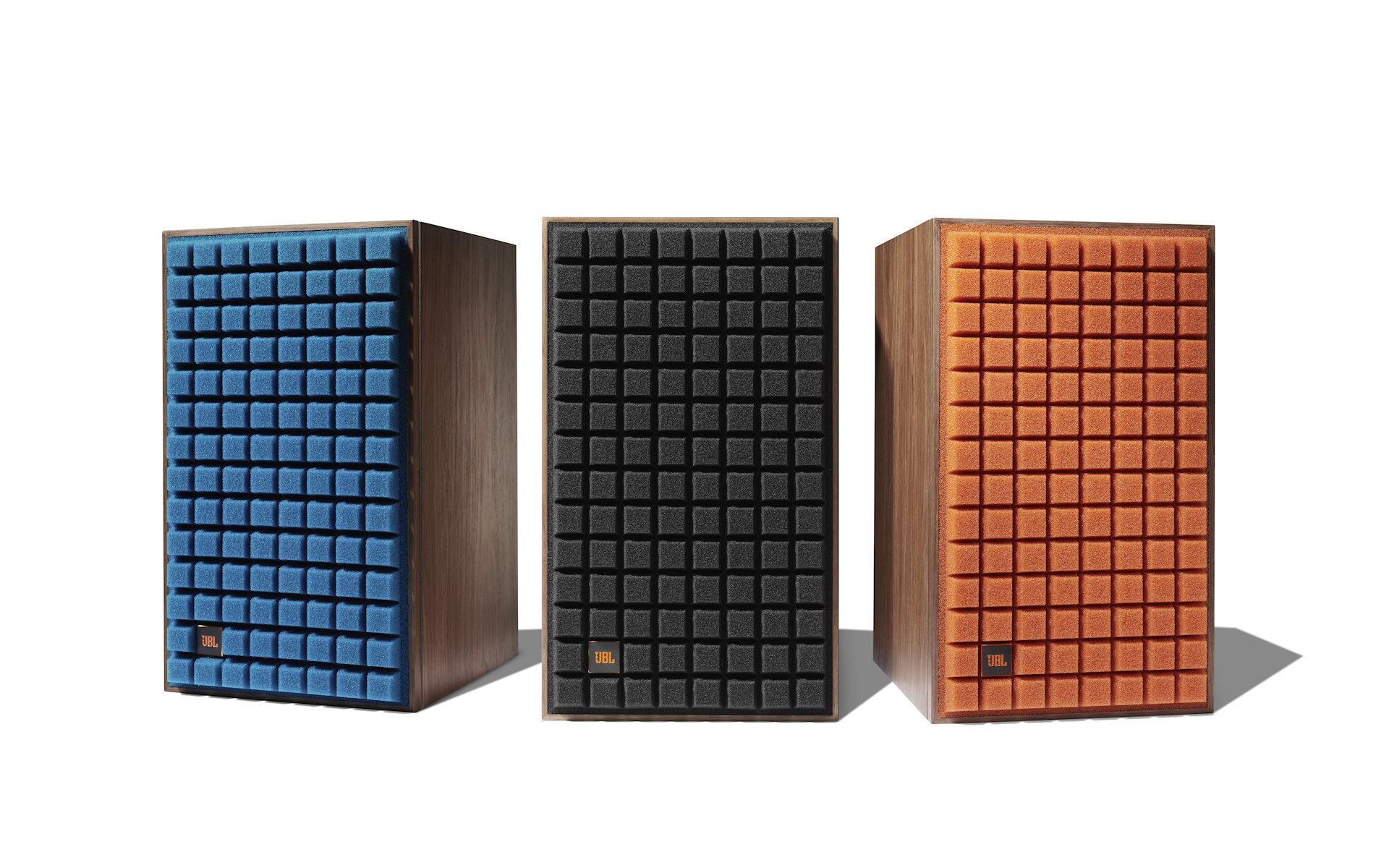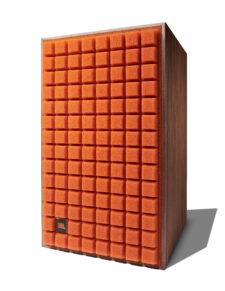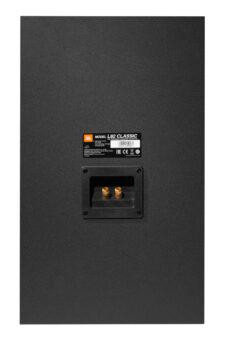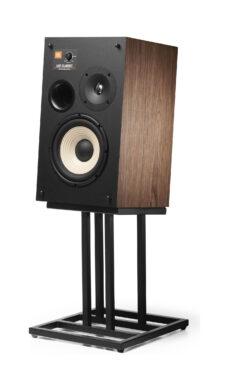

The only JBL speakers I've ever owned are/were located in the audio system of my 2010 Prius, but I blew them out years ago, most likely due to blasting a combination of Led Zeppelin and Coldplay at questionable volumes. That said, I have spent a good deal of time listening to the company's speakers, including the L100s, so I didn’t go into this review completely blind. Or should I say "deaf"? At any rate, you get the point.
 The L82 Classic is a riff on the L100 Classic, and it is, quite frankly, rad as all get-out. Though I wasn’t around when the L100s reigned supreme back in the day, from what I can tell the original look is still achieved with the Quadrex foam grille available in Black, Blue, or Orange (I was sent the orange) and a walnut cabinet that just screams “put me near your conversation pit and throw on some Cat Stevens.” As the L100’s cute little sisters, the L82s are much more of a bookshelf speaker, at a little over 18 inches tall by about 11 inches wide and 12.5 inches deep.
The L82 Classic is a riff on the L100 Classic, and it is, quite frankly, rad as all get-out. Though I wasn’t around when the L100s reigned supreme back in the day, from what I can tell the original look is still achieved with the Quadrex foam grille available in Black, Blue, or Orange (I was sent the orange) and a walnut cabinet that just screams “put me near your conversation pit and throw on some Cat Stevens.” As the L100’s cute little sisters, the L82s are much more of a bookshelf speaker, at a little over 18 inches tall by about 11 inches wide and 12.5 inches deep.
The L82 Classic has a two-way design that features an 8-inch pure pulp woofer with a front-facing port and 1-inch titanium dome tweeter with a waveguide. Rated frequency response is 44Hz to 40kHz with a sensitivity of 88dB. One of the most distinctive things about the L82 Classic, especially as compared with fully modern loudspeakers, is its high-frequency level control dial on the front, which allows you to adjust the level of the tweeter relative to the woofer.
 I'm a newbie when it comes to the world of hi-fi, and I don't have a ton of experience setting up passive speakers. But even I found the process of installing the L82 Classics and getting them dialed in relatively painless.
I'm a newbie when it comes to the world of hi-fi, and I don't have a ton of experience setting up passive speakers. But even I found the process of installing the L82 Classics and getting them dialed in relatively painless.
I connected the speakers to a Minx Xi integrated amplifier from Cambridge Audio using Analysis Plus speaker cables. I used a Panasonic UHD Blu-ray player as a source component, although most of my listening was done via my 2016 MacBook for Spotify Connect and iPhone XR for Tidal. I opted not to use an additional subwoofer for this review.
Being a recent graduate squatting in my parents’ home with no access to a designated listening room, I positioned the speakers in the living room -- about a foot away from the front wall and about six feet apart -- which I think is a pretty accurate representation of where most people would place the JBLs. Truth be told, the appeal of the L82 Classic is as much about aesthetics as sound -- maybe even more so -- and most would be loath to hide these beauties away. As for the high frequency level, I preferred to keep it closer to 0 dB, although I did fiddle with it every time I sat down to do some serious listening.
 JBL sells floor stands for the L82, which the company describes as an accessory and positions as an optional add-on. As far as I’m concerned, though, the JS-80 floor stands are necessary -- unless you want to stick these in your bookshelf or directly on the floor. That said, they still feel precarious. With no way of actually securing the speakers -- little hands, a trick knee, or a stray canine nose could shove these 27.9-pound speakers right off their perch and onto the floor -- their 18-inch height is only secured by small rubber feet that provide some grip, but not enough for my anxious mind.
JBL sells floor stands for the L82, which the company describes as an accessory and positions as an optional add-on. As far as I’m concerned, though, the JS-80 floor stands are necessary -- unless you want to stick these in your bookshelf or directly on the floor. That said, they still feel precarious. With no way of actually securing the speakers -- little hands, a trick knee, or a stray canine nose could shove these 27.9-pound speakers right off their perch and onto the floor -- their 18-inch height is only secured by small rubber feet that provide some grip, but not enough for my anxious mind.
If I had to choose between too much bass and too little, I would opt for the former every time, no question about it. So, my first impressions of the L82 Classic were promising, to say the least. Even without a subwoofer, these bookshelf speakers deliver impressive low-frequency output.
SBTRKT’s “New Dorp. New York,” is a song that will make a midsized sedan's windows and doors rattle even at moderate volume, and it ended up being one of my favorite songs to listen to on the L82 Classics. Ezra Koenig’s higher-pitched vocals sat perfectly on top the deep bass and complemented the percussion, which fades to the back and then explodes to overtake the song throughout the track.
Another song I found myself repeatedly cuing up on these speakers, mostly due to their fantastic imaging, is Hozier’s “Like Real People Do,” from his 2014 self-titled record. The song -- another simple track, with simple strings and occasional piano that also serves as the bass -- sounds eerily peaceful and beautifully melodic via the L82 Classics, just as it should. Hozier’s whisper-calm vocals, which sound more like a lullaby than folk rock, are not altered at the slightest, and the first piano keystroke at 1:04 does what it is intended to do: stops you in your tracks and forces you to really listen.
Similar to the JBL L100 speakers, the L82 Classics reach a certain point at which they sound brighter than may be preferred by most, and to a certain extent, it does affect the music you listen to. “15 Step,” off of Radiohead’s In Rainbows is a perfect example of a song that these speakers can drive extremely close to the edge of being harsh. The handclap rhythm and general percussion throughout the song feels edgy, but you can still hear the L82 Classic's quality through its ability to retain the mellowness of Thom Yorke’s voice. This seemed to be a theme with the speakers: although almost every song I listened to sounded great, there were times when you could feel the mix getting thinner than I prefer.
Similarly, the L82 Classics deliver the dynamic sound of “Pitch the Baby” and “Iceblink Luck” from the Cocteau Twins’ Heaven or Las Vegas wonderfully, which is a trick that a lot of speakers struggle with, given the band's penchant for reaching the highest and lowest of ranges within the span of three minutes and some change. Even with a very subtle bass line, the speakers accentuate every hi-hat hit and bass note. The speakers pull out every single detail of the mix, almost to a fault -- the higher pitch of the dreampop trio’s synths were especially accentuated.
As mentioned above, one thing the L82 Classics do particularly well is imaging. Spoon is a band that I can listen to anytime, anywhere, but there is really something about listening to them with a nicer speaker setup that really makes a difference. Arguably their most notable record, Ga Ga Ga Ga Ga, as well as one of their newer releases, 2014’s They Want my Soul, sounded fantastically balanced and really demonstrate the stereo imaging prowess of these small but surprisingly powerful speakers. Britt Daniel’s raspy voice is projected perfectly, and Jim Eno’s drums don’t become a muddled mix of drum-sounding claps like they do when I listen on most other systems. “Don’t You Evah,” is even more fun to listen to, being able to hear even the one-off conversation that starts the track in much better detail.
Unsurprisingly, the speakers excel when it comes to harder varieties of rock. Like its predecessors, the L82 seems to be made for bigger sound. From Paramore to Guns N’ Roses, I found that the four records I used to demo the speaker's capability in this genre sounded head-bangingly fantastic. Paramore’s Riot! and Brand New Eyes are perfect examples. The harsh guitar on “crushcrushcrush” doesn’t feel overly distorted, and Hayley William’s hair-raisingly powerful vocal focus on “All I Wanted” is perfectly isolated without even a hint of alteration, almost like she's right there in the room with you.
Guns N’ Roses’ “Coma,” one of the band's most expansive and diverse tracks, handles Slash’s guitar riffs and Steven Adler’s explosive drumming so well it doesn’t feel at all as if the speakers are under any type of stress. Axl Rose, one of the more versatile vocalists in the world of hair metal, comes through perfectly and even his higher vocal riffs almost slap you in the face -- the way they’re meant to.
“November Rain,” another long-winded heavy-hitter, does well with these speakers, especially considering the whiny guitar solo at 3:56 that lasts almost a minute and can feel more like screeching than sound of a '59 Les Paul. Speaking of whiny, the clarity of the speakers almost presents a problem for diehard Guns N’ Roses fans, since they force you to consider just how hard Rose strains for that raspy wail that he inserts in almost every song. These speakers don’t leave anything to the imagination, which to me is a welcome change.
As much as I love the bass and dynamic punch of these speakers, especially for their size, they do have a bit of an identity crisis. At $2,500 a pair, with the added expense of the pair of $250 stands, I have to wonder who these speakers are really for. Performance- and aesthetics-wise, they seem aimed more at the recent graduate squatting in their parents’ house. And needless to say, we can't afford them. And I honestly can't see a distinguished audiophile, for whom a $2,700 speaker-and-stand purchase almost borders on impulse-buy territory, loving their less-than- refined sound. Yes, the L82s are fantastically retro and can easily serve double-duty as an accent-piece in one’s living room, but the sound that is delivered is not quite consistent enough, nor is it really a good match for the sort of music that most audiophiles consume.
The L82 Classics seem to not be able to decide what they are. The passive design means you'll need additional equipment, at the very least a receiver or integrated amp, but the aesthetic begs to be displayed front and center, without the clutter of additional gear. Probably not for the discriminating audiophile, and maybe not for the homeowner looking for a retro look without the wires. It should be said, though, that I still love and fervently covet them. I just wish I could afford them.
Speaking of price point, the Focal Aria 906 ($1,990/pair) and Definitive Technology’s Demand Series D11 ($990/pair) offer similar sound capabilities and dimensions at a much lower price point, meaning that those on a budget can put some extra money towards a high-end receiver or integrated amp and subwoofer.
The Focal Aria 906 might be the best competition when it comes to appearance, but for sound, the Demand D11 is probably a better match for the bass extension of the L82 Classics, with both reporting a basement of 44Hz.
Easy to unpackage and extremely easy to set up, the L82 Classics are perfectly user-friendly, but as I mentioned earlier, it’s still unclear exactly who the target market is, aside from those who buy due to pure nostalgia. They don’t take up too much space, and are pretty enough that you can have them in any room and they actually add to the décor rather than become an eyesore.
The L82 Classics exhibit such rich, detailed sound, and even though they may falter in the higher frequencies, the music is never altered or distorted to the point that it becomes unlistenable or leaves you running for the volume knob. In fact, these speakers seem to be made for louder, more brash music, although they handle even whisper-like vocals and gentle strings with the same clarity. They may not be the first pick for the more critical audiophile or those who have a well-trained ear, but they are still worth a serious audition.
Additional Resources
• Visit the JBL Synthesis website for more product information.
• JBL Announces the L100 Classic Loudspeaker at HomeTheaterReview.com.
• JBL Synthesis L100 Classic Loudspeaker Review at HomeTheaterReview.com.